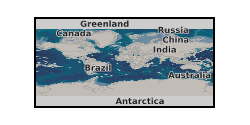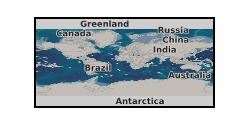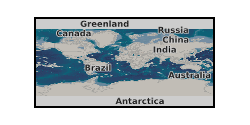National Oceanography Centre
Type of resources
Topics
Keywords
Contact for the resource
Provided by
Years
Formats
Representation types
Update frequencies
Resolution
-

This excel spreadsheet contains P-wave and S-wave velocity and attenuation data calculated with a novel rock physics model for hydrate bearing sediments. The model has been published in: Marín-Moreno, H., S. K. Sahoo, and A. I. Best (2017), Theoretical modeling insights into elastic wave attenuation mechanisms in marine sediments with pore-filling methane hydrate, Journal of Geophysical Research: Solid Earth, 122(3), 1835-1847, doi:10.1002/2016JB013577.
-
This marine sampling survey took place in July and August 1995 in the Hebridean Shelf edge area aboard the RSS Challenger as part of the LOIS Shelf Edge Study. Seabed sampling data was gathered using a box corer. For technical details of the survey contact Plymouth Marine Laboratory.
-
This marine geophysical and sampling survey took place over two legs (CD91A & CD91B) in March and April 1995 in the Hebridean Shelf edge area aboard the RSS Charles Darwin as part of the LOIS Shelf Edge Study. Sea floor data were collected using a echo-sounder and TOBI sidescan sonar. Seabed sampling data was gathered using Kasten corer, box corer, gravity corer. CTD, water sampling ADCP current profiler were also used. Seimic profiling was not collected due to weather conditions. Technical details of the survey are contained in POL Cruise Report 20.
-

Major, trace element and Pb isotope data are reported here for basalts recovered by drilling at the flanks of the Reykjanes Ridge, south of Iceland, during IODP Expedition 395C (2020-2022). The drilling targeted V-shaped ridges and V-shaped troughs forming the flanks of the Reykjanes Ridge. There were 4 sites drilled and sampled, and these include holes: U1554 (4F) - located on V-shaped trough 2B, holes U1555 (5I + 5G) - located on V-shaped trough 1, U1562 (2B), located on V-shaped ridge 3, and U1563 (3B) - located on V-shaped ridge 2A. Samples are predominately volcanic glasses and were recovered from cores drilled from up to 150m below the sediment-basement interface where they penetrated a series of pillow and sheet flow lavas. The sample name corresponds to the site, hole, core section and depth interval (see IODP Exp 395 site reports for details). Fresh volcanic glass was separated, cleaned in deionised water, picked under a binocular microscope to remove and altered material, cleaned again and then dissolved in HF and HCl prior to analyses. Major and trace elements abundances were analysed on an ICP-MS with a selection of geological reference materials (GRMs) used as standards. Pb isotopes ratios (206/204, 207/204 and 208/204) were measured on a neptune multicollector ICP-MS following using a double spike technique applied to the sample solutions. Reported here are the measured values of the GRMs and their uncertainties. The aim of this study was to test the hypothesis that the V-shaped ridges are the result of temperature and compositional pulses in a mantle plume, that is postulated to rise beneath Iceland and spread outward where it intersects the mid-ocean ridge to the south, and the effects of those pulses on climate over the last ~20Ma.
-

This database is from series of laboratory experiments designed to explore the effect of hydrate cementaion on some sands. This dataset is part of NERC Arctic Landslide-Tsunami Project (http://arp.arctic.ac.uk/projects/landslide-tsunami/) and has been presented in International conference and Journal article (under review) namely, 1) Madhusudhan, B.N. and Clayton, C.R.I. (2016) Influence particle size on strength of gas hydrate cemented granular materials. Wuttke, F., Bauer, S. and Sanchez, M. (eds.) In Energy Geotechnics. CRC Press. 742 pp, pp. 445-449. (doi:10.1201/b21938-71). 2) Madhusudhan,B.N, Clayton, C.R.I. and Priest, J.A ‘1 The Effects of Hydrate on the Strength and Stiffness of some Sands’. Under-review in Journal of Geophysical Research – Solid Earth.
-

The North Sea Interactive (NSI) project was an 8-month NERC funded project led by Heriot-Watt University, in collaboration with the BGS and NOC. The aim of the project was to develop a new decision-support tool that would translate existing marine environmental data into an interactive mapping product for the offshore oil and gas industry. The objectives of the project were achieved through the integration of the North Sea Benthos database (UKBenthos) with NERC's regional North Sea marine sediment data (BGS) and layers of modelled hydrodynamics (NOC). Aligning the biological, chemical, geological and hydrodynamic datasets in a single GIS product provides the oil industry and government regulators with a practical means of accessing this important archive of environmental data. The North Sea Benthos database (UKBenthos) was developed by Heriot-Watt University on behalf of UKOOA (now Oil and Gas UK) in the 1980s. Alongside macrobenthos, the database includes sediment properties, concentrations of aromatic compounds, total oil and metals. It currently includes data from 1975 to 2011 from 237 platforms and is continually being updated as new survey results are received by Oil and Gas UK.
-

Data for the figures in the manuscript: S. K. Sahoo, H. Marin-Moreno, L. J. North, I. Falco-Suarez,B. N. Madhusudhan, A. I. Best and T. A. Minshull (2018).Presence and consequences of co-existing methane gas with hydrate under two phase water-hydrate stability conditions , Journal of Geophysical Research: Solid Earth. https://doi.org/10.1029/2018JB015598
-
This dataset contains particulate and dissolved organic carbon concentrations, nutrients (ammonia, nitrates, phosphate), alkalinity, pH, particulate organic nitrogen, delta-C-13 and delta-15-N isotopes, fluorescence and absorbance from river water samples. Data come from 41 rivers from around Great Britain, sampled on a monthly basis during 2017. LOCATE (Land Ocean CArbon TransfEr) is a multi-disciplinary project that undertakes coordinated sampling of the major rivers in Great Britain to establish how much carbon from soils is getting into rivers and estuaries and to determine what is happening to it. LOCATE is a multidisciplinary NERC project involving the National Oceanography Centre, the British Geological Survey, the Centre for Ecology and Hydrology and the Plymouth Marine Laboratory, with assistance from the University of Lancaster, University of Durham, University of Hull, the University of the Highlands and Islands and the Environment Agency. Full details about this dataset can be found at https://doi.org/10.5285/08223cdd-5e01-43ad-840d-15ff81e58acf
-
This dataset contains monthly measurements of major and trace elements from 41 rivers around Great Britain. The samples were collected as part of the Land Ocean Carbon TransfEr (LOCATE) project during 2017 and they were analysed using Inductively coupled plasma mass spectrometry (ICP-MS). LOCATE was a multi-disciplinary NERC project that undertook coordinated sampling of the major rivers in Great Britain to establish how much carbon from soils is getting into rivers and estuaries and to determine what is happening to it. It involved the National Oceanography Centre, the British Geological Survey, the UK Centre for Ecology and Hydrology and the Plymouth Marine Laboratory, with assistance from the University of Lancaster, University of Durham, University of Hull, the University of the Highlands and Islands and the Environment Agency. Full details about this dataset can be found at https://doi.org/10.5285/ef880531-08b3-477d-a69e-3b28beb562d2
-

The excel table presents the high-resolution LA-MC-ICP-MS Pb isotope data (± 2S%) produced for the Paleocene interval of Fe-Mn crust core sample 085_004 recovered in 2016 during the JC142 expedition to Tropic Seamount for the MarineE-Tech project. A detailed description of the sample can be found in Josso et al., 2019 and 2020. The Scripts data are Matlab and R readable file presenting all scripts and built-in functions used during the processing of the data to demonstrate the presence of astronomical imprint on the cyclicity of the Pb isotope ratios.
 NERC Data Catalogue Service
NERC Data Catalogue Service